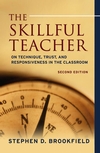
I just came back from a Teaching Excellence presentation here at Suffolk University. We heard from Stephen D. Brookfield, author of The Skillful Teacher; On technique, trust and responsiveness in the classroom. He has a website link, featuring a really unprepossessing photo. I think it's part of his ethos of breaking down barriers and demystifying the professor, but he didn't say why he chose such a spectacularly unflattering photo for his splash page. The book, and his talk, though, were both terrific. His first chapter is "Experiencing Teaching," and talks specifically about muddling through. Unlike so many of the How To books, he does not try to come across as a higher being. He shares his horror stories and brings a lot of honesty to the writing and speaking.
"Muddling through" is, according to Brookfield, an honorable response to the unpredictable in life and in the classroom. His anecdote about his first day teaching in college illustrates this. A racially-motivated fistfight broke out between two students. Brookfield thought to himself, "What would Dewey do?" And came up blank. Melville Dewey would never have confronted such a situation and had nothing to offer his modern disciple. The response: Muddle through.
But muddling through must be done critically, and with a close eye to the effectiveness of the muddling. I found the book and the speech comforting and exciting. The main tool for critically evaluating how the class is going is the Classroom Critical Incident Questionnaire. Brookfield says he hands it out once a week, even in courses that only meet weekly. There are five questions to answer, asking the moment where the student felt most engaged, and the most distanced. The student is also asked what action was most affirming or helpful, most puzzling or confusing, and what was most surprising. He requires students to fill out a carbon-copy form each week. The student hands in one copy and keeps the second in their notebook. At the end of the semester, each student must write one or two paragraphs about what they learned about how they learn, referring to these weekly questionnaires.
The professor receives the questionnaires anonymously. If the class is large, he will read 25 at random, or sometimes have a number studenns assigned to read 25 and summarize them (in a really large class, which he said could be up to 250!). This practice is made clear the first time the questionnaires are handed out. The students who are summarizers are released from some portion of weekly homework in exchange for this task. Brookfield reports back to the class on the positive AND the negative responses each week, assuring the class that he takes their responses seriously. He will modify the class or otherwise address problem raised in the questionnaire, although he is clear that he does not capitulate on key requirements.
I think this is an interesting feedback mechanism. Brookfield says he has used the questionnaire as a response mechanism for meetings as well, and that it works well in all settings, from high school, through college, to meetings of his academic department at the University of St. Thomas in Minnesota. In some ways, I have used the student responses and discussion of worksheets in my Advanced Legal Research class to gauge how effective I am being. I used to give a diagnostic exam at the first and last class. I always read student evaluations collected by the law school. This might be a very good addition to my arsenal for testing effectiveness. I certainly can endorse his characterization of teaching as muddling through, with the important addition of critical evaluation on a constantly repeating cycle.
No comments:
Post a Comment